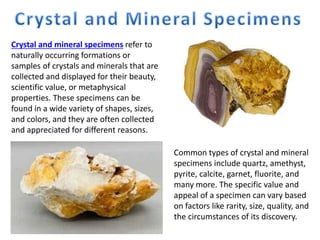Crystal and Mineral Specimens - Island Spiritual Shop
- 1. Crystal and mineral specimens refer to naturally occurring formations or samples of crystals and minerals that are collected and displayed for their beauty, scientific value, or metaphysical properties. These specimens can be found in a wide variety of shapes, sizes, and colors, and they are often collected and appreciated for different reasons. Common types of crystal and mineral specimens include quartz, amethyst, pyrite, calcite, garnet, fluorite, and many more. The specific value and appeal of a specimen can vary based on factors like rarity, size, quality, and the circumstances of its discovery.
- 2. Scientific Study: Mineral specimens are essential for geological research and education. Geologists and scientists study these specimens to understand the Earth's composition, mineral properties, and the processes that formed them. They provide valuable insights into the Earth's history and the conditions under which minerals and crystals form. Aesthetic and Decorative: Many people collect crystals and mineral specimens for their natural beauty. Some specimens are prized for their striking colors, intricate formations, or rare qualities. These specimens are often displayed in homes, museums, and galleries as decorative pieces.
- 3. Metaphysical and Healing: Some individuals believe that crystals and minerals possess metaphysical or healing properties. They use specific crystals and mineral specimens for meditation, energy work, and spiritual purposes. Each type of crystal or mineral is associated with different qualities and energies, as per various belief systems.
- 4. Lapidary and Jewelry Making: Gemstones and certain minerals, when cut and polished, are used to create jewelry and other ornamental items. Lapidaries work with raw mineral specimens to transform them into gemstones that are suitable for use in rings, necklaces, and other jewelry. Collecting and Hobby: Collectors are drawn to the diversity of minerals and crystals that can be found in the natural world. Some people make it a hobby to search for, identify, and collect mineral specimens from different locations, and they often build extensive collections. For those interested in collecting or working with crystal and mineral specimens, it's essential to research and handle them with care, as some specimens may be delicate or require specific preservation methods.




